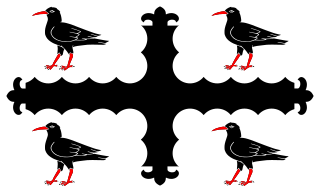
Until 1974, Flintshire, also known as the County of Flint, was an administrative county in the north-east of Wales, later classed as one of the thirteen historic counties of Wales.

The Salusbury family was a Anglo-Welsh family notable for their social prominence, wealth, literary contributions and philanthropy. They were patrons of the arts and were featured in William Shakespeare's The Phoenix and the Turtle and other works. The family mostly rose in power by supporting the rising Tudor dynasty.
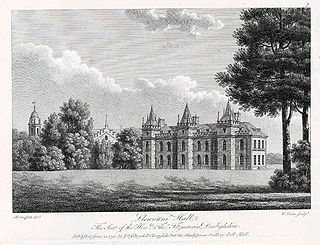
Lleweni Hall was a stately home in Denbighshire, northeast Wales, around 2 miles (3.2 km) north-east of Denbigh on the banks of the River Clwyd. It was the principal seat of the Salusbury family and their descendants from 1289 until 1748, and the present territorial designation of the most senior branch of the family.

Stansty is an area and electoral ward in Wrexham County Borough, Wales, lying to the immediate north-west of the city of Wrexham. It is a former civil parish and township. Stansty is also an electoral ward to Wrexham County Borough Council. The ward population as taken at the 2011 Census was 2,114.

Trevalyn Hall in Rossett, a Grade II* listed building, is an Elizabethan manor house near Wrexham in Wales. It was built by John Trevor in 1576. The Trevor family of Trevalyn were one of the leading families in East Denbighshire by about 1600 with numerous estates in both Flintshire and Denbighshire. The Plas Teg estate in Hope, Flintshire was also acquired by the Denbighshire branch of the family when it was purchased from a cousin by Sir John Trevor I (1563–1630) and it was he who built the present Plas Teg house in 1610.
Sir John Salusbury was a Welsh nobleman, explorer and co-founder of Halifax, Nova Scotia. He is credited as being one of the founders of modern Canada along with several other members of his expedition, including the Earl of Halifax and Edward Cornwallis. He served on the Nova Scotia Council throughout Father Le Loutre's War. He participated in the Battle at Chignecto. His diaries regarding the military campaign to establish a colony in Nova Scotia on behalf of the British Government became a vital source of information regarding the hardships, difficulties and opposition from the average Englishman regarding the development of the colony. He was a direct descendant of Katheryn of Berain.
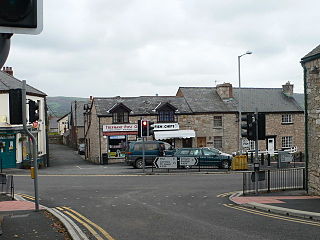
Trefnant is a village and community in Denbighshire, Wales. It is located on the A525 road in the Vale of Clwyd, about halfway between St Asaph (Llanelwy) to the north and Denbigh to the south. At the 2001 Census, the community had a population of 1,409, increasing to 1,581 at the 2011 Census.
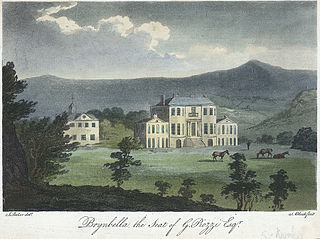
Brynbella is a neoclassical villa built near the village of Tremeirchion in Denbighshire, northeast Wales, by Hester Piozzi and her husband, Gabriel Piozzi. It was the seat of the Salusbury family from 1794 until 1920. The name is part Welsh and part Italian, meaning "Beautiful Hill".

The first High Sheriff of Denbighshire was John Salusbury, snr, appointed in 1540. The shrievalty of Denbighshire, together with that of Flintshire, continued until 1974 when it was abolished after the county and shrievalty of Clwyd was created.

Sir Thomas Salusbury, 2nd Baronet was a Welsh poet, politician and soldier, who supported King Charles I in English Civil War and was a colonel of a Royalist regiment.
William Salusbury (1580–1660) was a Welsh privateer in the East Indies, poet and politician who sat in the House of Commons from 1621 to 1622. He was governor of Denbigh Castle, fought on the Royalist side in the English Civil War and held out for over six months until the final days of the war and only surrendered on the written instruction of Charles I.

Maenan Abbey was a monastic religious house located in Maenan, Conwy, Wales. It is situated near Llanrwst.
Marchwiel Hall is a Grade II listed building in the village of Marchwiel, Wrexham County Borough in North Wales.
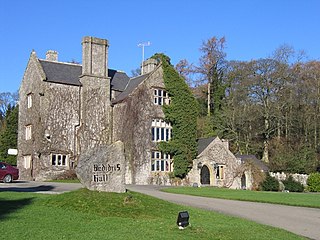
Sir Evan Lloyd, of Bodidris, Llanarmon yn Iâl, Denbighshire, was a Welsh politician, Member of Parliament. He was High Sheriff of Denbighshire and took part in the Earl of Leiceister's expedition.

John Salesbury (1533–1580), of Rûg, near Corwen, Merionethshire and Bachymbyd, near Ruthin, Denbighshire, was a Welsh politician.

Nantclwyd Hall is a 17th-century Grade II* listed mansion near the village of Llanelidan, Denbighshire, Wales, built by the Parry family, and rebuilt by Eubule Thelwall and his wife Mary Parry, the heiress of the estate.

Maenan Hall is a Grade I-listed hall house north west of the village of Llanddoged, Conwy, Wales. This late medieval country mansion has fine decorative plasterwork and was the home of the Kyffin family. It is privately owned, but the extensive gardens are open to the public on a few occasions each year.
Townshend Mainwaring was a British Conservative Party politician.

Holy Trinity Church is a Grade II* listed building in Trefnant, Denbighshire, Wales. It forms part of a group of listed structures in the village, including a parsonage and school, that were designed by George Gilbert Scott and which are recognised as a significant parochial architectural group.

The Lordship of Bromfield and Yale was formed in 1282 by the merger of the medieval commotes of Marford, Wrexham and Yale. It was part of the Welsh Marches and was within the cantref of Maelor in the former Kingdom of Powys.















